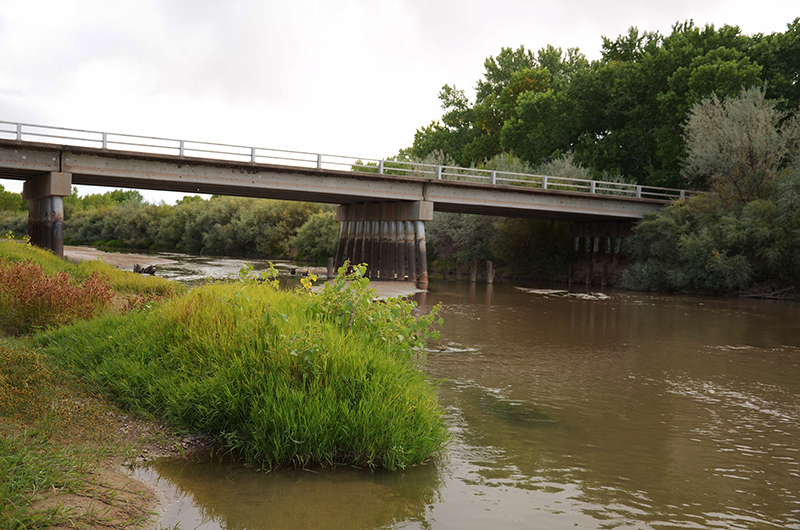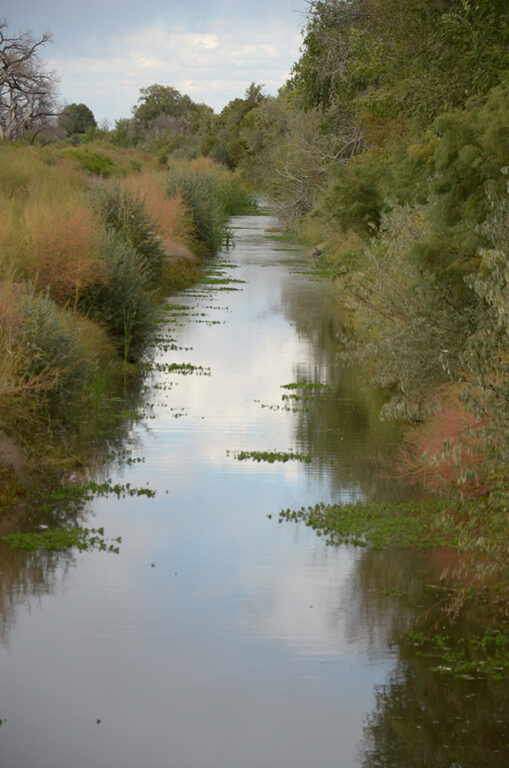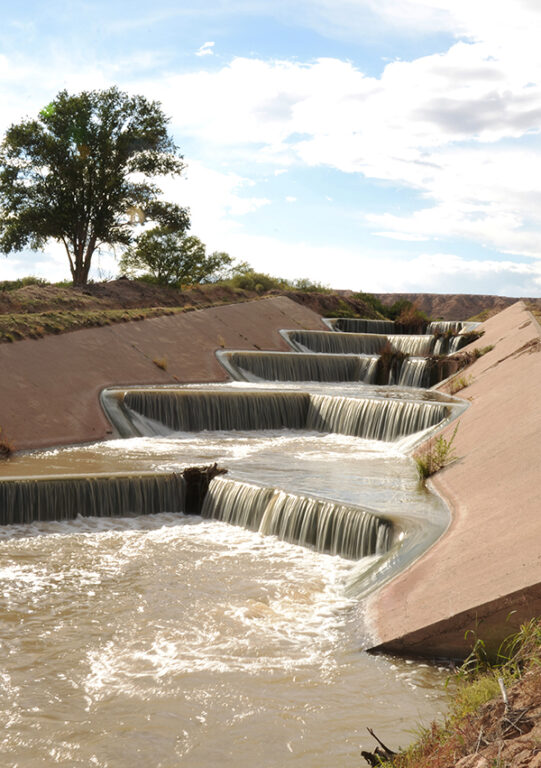Water is one of the most important natural resources and, as it dries up, water rights become increasingly important.
Water history of New Mexico
To understand modern water rights, we must look at the history of New Mexico’s water use.
By the time the Spaniards came to the Land of Enchantment in the mid-1500s, the Indigenous people who lived in the Pueblos and tribes had been using ancient irrigation methods to water crops using ditches and canals for hundreds of years.
Spanish settlers brought new ideas and rules from Europe regarding water usage. The acequia system is an important system they brought here and it’s still in use today.
Acequias were developed by the Moors of Northern Africa, who took them to Spain around the eighth century.
Acequias were the water management system for Spanish colonial New Mexico. Today, they have evolved into community ditch systems with about 800 different associations in the state.
The Spaniards in New Mexico gave the responsibility of distributing water in equitable shares to the Spanish and Indigenous rural populations. During the Mexican-American War in 1846, Gen. Kearny peacefully took control of the New Mexico Territory from Mexico. He established the Kearny Code, which preserved pre-existing Spanish and Mexican laws, including water rights.
The Mexican-American War came to an end when the two countries signed the Treaty of Guadalupe Hidalgo in 1848, officially transferring New Mexico and California to the United States.
“In the Middle Rio Grande, we have six Pueblos. The Treaty of Guadalupe Hidalgo confirmed the Pueblos’ water rights. Mexico recognized them and then it was ratified by Congress,” said Stephanie Russo Baca, staff attorney at the Utton Center at the UNM School of Law and ombudsman.
In the 1880s, the railroads brought settlers, miners and investors into the West, which spurred changes in the water laws of territorial New Mexico. Miners staking claims in the region needed to divert water for their mines.
The territory needed to determine the water rights of diverting the flow of streams. So, the territory adopted the concept based on the Western mining laws principle, “first in time, first in right,” resulting in the development of the prior appropriation doctrine. Those who diverted and beneficially used the water first had senior water rights.
In an 1891 court decision, the New Mexico Territorial Supreme Court ruled that prior appropriation was the law of New Mexico. The court ruled in favor of a mill owner who claimed to have prior appropriation of water rights over another landowner’s water rights who claimed to have riparian rights — or legal ownership rights attached to waterfront property.
Law of the land and water
New Mexico’s current water laws stem from a water code adopted in 1907 by the Territorial Legislature.
“When I think about that code, I think about the continuity and change, the wisdom and restraint embodied in New Mexico’s basic water law, now (116) years old and still alive and well in a water world its authors never could have imagined,” wrote Emlen Hall, professor emeritus at the University of New Mexico School of Law, in a 2007 essay.
The 1907 Water Code established the Office of the Territorial Engineer, now the Office of the State Engineer, to manage water rights based on beneficial use.
The Legislature gave the new water czar authority to make decisions about water in New Mexico, which included measuring, appropriating and the distribution of water.
When New Mexico became a state in 1912, the state constitution made the Water Code of 1907 the cornerstone of Article 16 — Irrigation and Water Rights — which is the basis of what a water right is.
Article 16 formally established the principles of public ownership of water, prior appropriation and beneficial use.
Section 1 of Article 16 of the New Mexico Constitution states all existing water rights prior to the constitution were confirmed.
Section 2 states that all unappropriated water belongs to the public and is subject to appropriation by beneficial use and priority of appropriation is given to the better right.
Water is an usufructuary property, or the right to use and benefit from water, not the right to own the water.
“It’s almost like leasing a vehicle. You can use it but you don’t actually ever get to own it,” says Russo Baca, who is chairwoman of the Middle Rio Grande Conservancy District Board of Directors.
Water rights are determined by who first used the water beneficially in chronological order — first in time, first in right.
Section 3 states that beneficial use shall be the basis, the measure and the limit of the right to the use of water. Beneficial use means that water is being used in a socially accepted, beneficial way.
Beneficial use: basis, measure and limit
If you don’t have a beneficial use of water, you do not have a water right. When someone applies for a water rights permit, they must show basis, measure and limit.
The basis is the beneficial purpose the water is used for. The measure of the water is how much water is being used. The limit is the amount of water you can use based on the historical measure.
Russo Baca gives this as an example — say you pour one full glass of water every day but you only drink half of it. You are only going to have a right to half a glass of water, not the full amount you poured. If you drink the whole glass once, then you could have a right to the whole glass.
The basis, measure and limit are the cap based on your historical usage.
What is beneficial use?
There is no definition in the New Mexico Constitution of what beneficial use is.
There are, however, judicial and state engineer rulings that set precedents of what beneficial uses are. The uses include irrigation, domestic, wildlife, commercial and industrial.
The state does know what is not beneficial water use — wasting, hoarding, speculating or illegally using water is a crime in New Mexico.
Examples of wasting water include over-watering, letting it spill onto the roadways or irrigating weeds.
“You can’t just collect water rights and be like a dragon guarding its hoard of water rights,” Russo Baca added.
The New Mexico’s San Augustine Plains case is an example where a water rights permit was denied by the OSE due to speculation.
Augustin Plains Ranch LLC is a foreign-owned company that has been denied by the OSE three times in a 15-year period and each time the company sued.
The company requested permission to extract billions of gallons of water per day from the San Agustin aquifer near Datil, N.M. However, they did not disclose the identity of their customers.
The legal dispute is ongoing, and APR has filed lawsuits against the state engineer each time the proposal was rejected. In the last denial, the district court ruled the legal doctrine of collateral estoppel should be applied to prevent endless litigation.
However, the New Mexico Court of Appeals ruled the district court was wrong and sent it back.
“You will see that in the decision they said they were just buying up all these water rights and hoarding them to proactively build a neighborhood that didn’t actually have a good plan,” explained Russo Baca.
Elements of water rights
Water rights typically consist of six elements: priority date of appropriation, quantity appropriated, point of diversion, place of use, purpose of use and water source. These are the factors the OSE considers when reviewing applications.
Priority date — first in time, first and right.
The priority date of a water right is determined by the owner’s initial actions to utilize the water for beneficial purposes. This date is crucial in determining senior or junior water rights.
Senior rights holders have precedence and will receive their full allocation of water during times of shortage, while junior rights holders may receive a reduced amount or no water at all.
Pueblos hold the oldest water rights in the state, dating back to “time immemorial.”
Priority date is when the first shovel load was dug, the well construction began or the date when the water rights application was filed with the OSE.
The priority date for federally-reserved water rights is when the federal action was taken to reserve the right.
Quantity of water
The way a water right is quantified is the Farm Delivery Requirement and the Consumptive Use amount or Consumptive Irrigation Requirement.
You can think of the FDR as a carriage system of water that carries the CU from the point of diversion to the place of use. The FDR returns to the system so someone else can use the water.
Water rights are typically expressed in units of acre-feet per year.
An example would be a 10-acre farm that has a water right that allows for the diversion of 40 AFY. With a consumptive use amount of 20 AFY, the remaining 20 acre-feet of water must be returned to the system.
Point of diversion and place of use
The point of diversion is the location where water is diverted, which can include ditches, head gates and wells. The place of use is the specific tract of land where the water is being put to beneficial use.
Both the point of diversion and the place of use are fixed and can only be changed with a permit from the OSE.
The point of diversion is where the water is extracted and the place of use is where it is applied. They might not be in the same location.
“The Isleta Diversion Dam is the main point of diversion for all of Valencia County surface water because that’s where it’s diverted from the river. You have another point of diversion at your individual headgate,” says Russo Baca.
Purpose of use
Water rights must stipulate what purpose the water will be used for. New Mexico’s water rights are based on equal treatment, without regard to equity, and are contingent on beneficial use.
Some of the uses include irrigation or agriculture, commercial, municipal, domestic, industrial, stock and environmental.
A recent example of beneficial environmental use is Audubon Southwest leasing 580 acre-feet of water from local municipalities to release into the Rio Grande to help endangered species, such as the silvery minnow.
Source of water
The source refers to whether water comes from groundwater or surface water. They are managed jointly because the state recognizes the interconnectedness of ground and surface water within the boundary of systems or basins.
The OSE declares boundaries of groundwater basins using hydrological surveys, and surface water is typically found in stream systems.
A water transfer must stay within the same basin due to a lack of interconnectivity between stream systems and aquifer basins.
Pathways to recognized water rights
The 1907 water code gave the OSE jurisdiction over all new surface water appropriation. Any water rights pre-1907 are protected and considered senior, while post-1907 water rights must go through an application process.
The OSE can assert jurisdiction over any groundwater basin by issuing a basin declaration. After the basin has been declared, any new appropriations must also be applied.
If a water rights owner wants to change any element of their rights, they must make a declaration with the OSE. It is not official until it is permitted.
“You can declare you’re a unicorn but it doesn’t make it true,” said Russo Baca. “You can declare something but that is all it is, a declaration until it is permitted through the state engineer.”
Obtaining a permit is a lengthy process that could take six to eight months at a minimum. If there are protests, the process could extend to two years or more.
Adjudication refers to the legal process of establishing the right to use specific water. The purpose of adjudication is to describe water uses in a stream system so the OSE can apportion and manage water stipulated by state statutes.
The Middle Rio Grande Valley has not gone through the formal process and is an unadjudicated basin.
People can forfeit their water rights if they fail to beneficially use water for a period of four consecutive years.
Abandonment of a water right requires nonuse and the intent to abandon it.
For more information on water rights in New Mexico, visit the Utton Transboundary Resources Center, UNM School of Law at theuttoncenter.unm.edu or the Office of the State Engineer at ose.state.nm.us/.
Jesse Jones lives in Albuquerque with his wife and son. Jesse graduated from of the University of New Mexico twice. This spring, he graduated with a degree in multimedia journalism and, in 2006, he received a bachelor’s degree in university studies with an emphasis in photojournalism. He is a current fellow of the New Mexico Local News Fund.





















